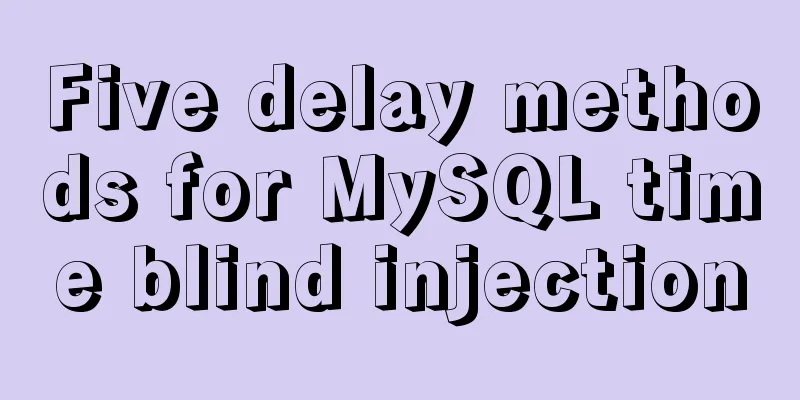Preventing SQL injection in web projects

1. Introduction to SQL InjectionSQL injection is one of the more common network attack methods. It does not use operating system bugs to implement attacks, but targets programmers' negligence when writing programs. It uses SQL statements to achieve accountless login and even tamper with the database. 2. The overall idea of SQL injection attack
SQL injection attack examplesFor example, on a login interface, you are asked to enter your username and password: You can enter this to log in without an account: Username: 'or 1 = 1 – password: Click login. If no special processing is done, the illegal user will be able to log in easily. (Of course, some database APIs in some languages have already handled these problems.) Why is this? Let's analyze it below: Theoretically, the background authentication program will have the following SQL statements: String sql = "select * from user_table where username= ' "+userName+" ' and password=' "+password+" '"; When the above username and password are entered, the above SQL statement becomes: SELECT * FROM user_table WHERE username= ''or 1 = 1 -- and password='' """ Analyze SQL statements: If the condition is followed by username=”or 1=1 username is equal to” or 1=1, then this condition will definitely succeed; Then add two - at the end, which means comment. It comments the following statements and makes them ineffective. In this way, the statements can always be executed correctly, and users can easily deceive the system and obtain legal identities. This is still relatively gentle. If you execute SELECT * FROM user_table WHERE username='' ;DROP DATABASE (DB Name) --' and password='' The consequences can be imagined... """ 4. How to prevent SQL injection
1. Check variable data type and formatIf your SQL statement is in the form of where id={$id}, and all ids in the database are numbers, you should check to make sure that the variable id is of int type before the SQL is executed. If you are receiving an email, you should check and strictly ensure that the variable is in the format of an email address. The same is true for other types such as date, time, etc. To sum up: as long as there are variables in a fixed format, they should be strictly checked according to the fixed format before the SQL statement is executed to ensure that the variables are in the format we expect, which can largely avoid SQL injection attacks. For example, in our previous example of accepting username parameters, our product design should have a username rule at the beginning of user registration, such as 5-20 characters, which can only be composed of uppercase and lowercase letters, numbers and some safe symbols, and no special characters. At this point we should have a check_username function to perform unified checks. However, there are still many exceptions to this rule, such as article publishing systems, comment systems, etc., which must allow users to submit arbitrary strings. This requires the use of other solutions such as filtering. 2. Filter special symbolsFor variables that cannot be determined in a fixed format, special symbols must be filtered or escaped. 3. Bind variables and use precompiled statementsMySQL's mysqli driver provides support for prepared statements. Different programming languages have their own methods for using prepared statements. In fact, using precompiled statements to bind variables is the best way to prevent SQL injection. The semantics of precompiled SQL statements will not change. In SQL statements, variables are represented by question marks?. Even if hackers are very skilled, they cannot change the structure of SQL statements. summary:
In general, to prevent general SQL injection, you only need to pay attention to the code standards. The above is what I introduced to you about preventing SQL injection in web projects. I hope it will be helpful to you. I would also like to thank everyone for their support of the 123WORDPRESS.COM website! You may also be interested in:
|
<<: Appreciation of the low-key and elegant web design in black, white and gray
>>: HTML tag meta summary, HTML5 head meta attribute summary
Recommend
HTML Tutorial: HTML horizontal line segment
<br />This tag can display a horizontal line...
Solve the problem of blank gap at the bottom of Img picture
When working on a recent project, I found that th...
Detailed explanation of the process of setting up nvidia-docker environment on Linux server
Docker is equivalent to a container, which can bu...
VSCode Development UNI-APP Configuration Tutorial and Plugin
Table of contents Written in front Precautions De...
Introduction to the use of html base tag target=_parent
The <base> tag specifies the default address...
Detailed explanation of possible problems in converting floating point data to character data in MySQL
Preface This article mainly introduces a problem ...
Summary of common tool examples in MySQL (recommended)
Preface This article mainly introduces the releva...
Detailed explanation of creating stored procedures and functions in mysql
Table of contents 1. Stored Procedure 1.1. Basic ...
Self-study of MySql built-in functions knowledge points summary
String functions Check the ascii code value of th...
Detailed explanation of MLSQL compile-time permission control example
Preface The simple understanding of MySQL permiss...
Detailed explanation of MySQL cursor concepts and usage
This article uses examples to explain the concept...
Solution to data duplication when using limit+order by in MySql paging
Table of contents summary Problem Description Ana...
Example code showing common graphic effects in CSS styles
Let me briefly describe some common basic graphic...
Detailed explanation of the practice of installing the Permeate range system using VMware
1. Background We do some internal training from t...
Let's talk about what JavaScript's URL object is
Table of contents Overview Hash Properties Host p...









